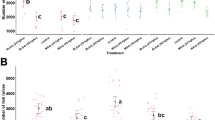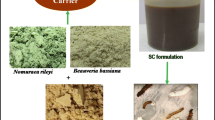Abstract
This study was sought to devise pellets containing inorganic materials and microsclerotia of Metarhizium anisopliae strain IP 119 for biological control of Rhipicephalus microplus, the most economically important tick in Brazilian cattle industry. In addition, we evaluated the storage stability of the pellets, their tolerance to ultraviolet radiation (UV-B), and efficacy against ticks under laboratory conditions. Fungal microsclerotia were produced by liquid culture fermentation and mixed with pre-selected inorganic matrices: vermiculite powder, diatomaceous earth, and colloidal silicon dioxide (78:20:2, w/w/w). The microsclerotial pellets were then prepared by a two-stage process involving extrusion and spheronization. Pellet size averaged 525.53 ± 7.74 μm, with a sphericity index of 0.72 ± 0.01, while biomass constituents did not affect the wet mass properties. Conidial production from microsclerotial pellets upon rehydration ranged from 1.85 × 109 to 1.97 × 109 conidia g−1 with conidial viability ≥ 93%. Conidial production from pellets stored at 4 °C was invariable for up to 21 days. Unformulated microsclerotia and microsclerotial pellets were extremely tolerant to UV-B compared with aerial conidia. Engorged tick females exposed to conidia from sporulated pellets applied to soil samples and upon optimal rehydration exhibited shorter oviposition time length, shorter life span, and reduced number of hatched larvae. In summary, microsclerotial pellets of M. anisopliae IP 119 effectively suppressed R. microplus and showed outstanding UV-B tolerance in laboratory tests. Prospectively, this formulation prototype is promising for targeting the non-parasitic stage of this tick on outdoor pasture fields and may offer a novel mycoacaricide for its sustainable management.
Key points
• Pellets with microsclerotia and inorganic materials are innovative for tick control.
• Metarhizium microsclerotia show superior UV-B tolerance in relation to conidia.
• Pellets of Metarhizium microsclerotia produce infective conidia against ticks.






Similar content being viewed by others

Data availability
The datasets generated and analyzed during the current study are available from the corresponding authors on reasonable request.
References
Alencar RG, Oliveira AC, Lima EM, Cunha-Filho MSS, Taveira SF, Marreto RN (2017) Compacted multiparticulate systems for colon-specific delivery of ketoprofen. AAPS Pharm Sci Tech 18:2260–2268. https://doi.org/10.1208/s12249-016-0700-2
Behle RW, Jackson MA (2014) Effect of fermentation media on the production, efficacy, and storage stability of Metarhizium brunneum microsclerotia formulated as a prototype granule. J Econ Entomol 107:582–590. https://doi.org/10.1603/EC13426
Braga GUL, Flint SD, Miller CD, Anderson AJ, Roberts DW (2001) Variability in response to UV-B among species and strains of Metarhizium isolated from sites at latitudes from 61°N to 54°S. J Invertebr Pathol 78:98–108. https://doi.org/10.1006/jipa.2001.5048
Camargo MG, Golo PS, Angelo IC, Perinotto WMS, Sá FA, Quinelato S, Bittencourt VREP (2012) Effect of oil-based formulations of acaripathogenic fungi to control Rhipicephalus microplus ticks under laboratory conditions. Vet Parasitol 188:140–147. https://doi.org/10.1016/j.vetpar.2012.03.012
Camargo MG, Nogueira MRS, Marciano AF, Perinoto WMS, Coutinho-Rodrigues CJB, Scott FB, Angelo IC, Prata MCA, Bittencourt VREP (2016) Metarhizium anisopliae for controlling Rhipicephalus microplus ticks under field conditions. Vet Parasitol 223:38–42. https://doi.org/10.1016/j.vetpar.2016.04.014
Chagas ACS, Nascimento CB, Furlong J (2001) Comportamento e ecologia de fêmeas ingurgitadas do carrapato Boophilus microplus em pastagem de Brachiaria decumbens no Brasil. Braz J Vet Res Anim Sci 38:188–191
Chamsai B, Sriamornsak P (2013) Novel disintegrating microcrystalline cellulose pellets with improved drug dissolution performance. Powder Technol 233:278–285. https://doi.org/10.1016/j.powtec.2012.08.019
Corval ARC, Silva EM, Corrêa TA, Ribeiro-Silva CS, Bitencourt ROB, Fernandes ÉKK, Bittencourt VREP, Roberts DW, Gôlo PS (2020) UV-B tolerances of conidia, blastospores, and microsclerotia of Metarhizium spp. entomopathogenic fungi. J Basic Microbiol 61:15–26. https://doi.org/10.1002/jobm.202000515
Cunha TA, Serpa RC, Oliveira APM, Nasser LN, Freitas LAP, Taveira SF, Diniz DGA, Lima EM, Marreto RN (2013) Effect of stearic acid on enalapril stability and dissolution from multiparticulate solid dosage forms. AAPS Pharm Sci Tech 14:1150–1157. https://doi.org/10.1208/s12249-013-0006-6
Dukić-Ott A, Thommes M, Remon JP, Kleinebudde P, Vervaet C (2009) Production of pellets via extrusion–spheronisation without the incorporation of microcrystalline cellulose: a critical review. Eur J Pharm Biopharm 71:38–46. https://doi.org/10.1016/j.ejpb.2008.08.005
Fernandes ÉKK, Bittencourt VREP (2008) Entomopathogenic fungi against South American tick species. Exp Appl Acarol 46:71–93. https://doi.org/10.1007/s10493-008-9161-y
Fernandes ÉKK, Bittencourt VREP, Roberts DW (2012) Perspectives on the potential of entomopathogenic fungi in biological control of ticks. Exp Parasitol 130:300–305. https://doi.org/10.1016/j.exppara.2011.11.004
Fernandes ÉKK, Rangel DEN, GUL B, Roberts DW (2015) Tolerance of entomopathogenic fungi to ultraviolet radiation: a review on screening of strains and their formulation. Curr Genet 61:427–440. https://doi.org/10.1007/s00294-015-0492-z
Fernandes ÉKK, Marreto RN, Luz C, Catão AML, Paixão FRS, Santos, TR, Mascarin, GM (2017) Composição e processo de preparação multiparticulada de natureza sólida contendo microescleródios de Metarhizium anisopliae para controle de artrópodes-praga de importância na saúde humana, veterinária e na agropecuária e seus usos. Brazil. Patent registered in Brazil, BR1020170040615.
Grisi L, Leite RC, Martins JRDS, Barros ATMD, Andreotti R, Cançado PHD, León AAPD, Pereira JB, Villela HS (2014) Reassessment of the potential economic impact of cattle parasites in Brazil. Rev Bras Parasitol Vet 23:150–156. https://doi.org/10.1590/S1984-29612014042
Horaczek A, Viernstein H (2004) Comparison of three commonly used drying technologies with respect to activity and longevity of aerial conidia of Beauveria brongniartii and Metarhizium anisopliae. Biol Control 31:65–71. https://doi.org/10.1016/j.biocontrol.2004.04.016
Jackson MA, Jaronski ST (2009) Production of microsclerotia of the fungal entomopathogen Metarhizium anisopliae and their potential for use as a biocontrol agent for soil-inhabiting insects. Mycol Res 113:842–850. https://doi.org/10.1016/j.mycres.2009.03.004
Jackson MA, Jaronski ST (2012) Development of pilot-scale fermentation and stabilisation processes for the production of microsclerotia of the entomopathogenic fungus Metarhizium brunneum strain F52. Biocontrol Sci Tech 22:915–930. https://doi.org/10.1080/09583157.2012.696578
Jackson MA, Dunlap CA, Jaronski ST (2010) Ecological considerations in producing and formulating fungal entomopathogens for use in insect biocontrol. BioControl 55:129–145. https://doi.org/10.1007/s10526-009-9240-y
Jaronski ST, Jackson MA (2008) Efficacy of Metarhizium anisopliae microsclerotial granules. Biocontrol Sci Tech 18:849–863. https://doi.org/10.1080/09583150802381144
Klafke G, Webster A, Dall Agnol B, Pradel E, Silva J, de La Canal LH, Becker M, Osório MF, Barreto MMR, Scheffer R, Souza UA, Corassini VB, Santos J, Reck J, Martins JR (2017) Multiple resistance to acaricides in field populations of Rhipicephalus microplus from Rio Grande do Sul state, Southern Brazil. Ticks Tick Borne Dis 8:73–85. https://doi.org/10.1016/j.ttbdis.2016.09.019
Kobori NN, Mascarin GM, Jackson MA, Schisler D (2015) Liquid culture production of microsclerotia and submerged conidia by Trichoderma harzianum active against damping-off disease caused by Rhizoctonia solani. Fungal Biol 119:179–190. https://doi.org/10.1016/j.funbio.2014.12.005
Marciano AF, Mascarin GM, Franco RFF, Golo OS, Jaronski ST, Fernandes ÉKK, Bittencourt VREP (2021) Innovative granular formulation of Metarhizium robertsii microsclerotia and blastospores for cattle tick control. Sci Rep 11:4972. https://doi.org/10.1038/s41598-021-84142-8
Mascarin GM, Kobori NN, Vital RCJ, Jackson MA, Quintela ED (2014) Production of microsclerotia by Brazilian strains of Metarhizium spp. using submerged liquid culture fermentation. World J Microbiol Biotechnol 30:1583–1590. https://doi.org/10.1007/s11274-013-1581-0
Moore D, Douro-Kpindou OK, Jenkins NE, Lomer CJ (1996) Effects of moisture content and temperature on storage of Metarhizium flavoviride conidia. Biocontrol Sci Tech 6:51–62. https://doi.org/10.1080/09583159650039520
Muley S, Nandgude T, Poddar S (2016) Extrusion-spheronization a promising pelletization technique: In-depth review. Asian J Pharm Sci 11:684–699. https://doi.org/10.1016/j.ajps.2016.08.001
Muniz ER, Paixão FRS, Barreto LP, Luz C, Arruda W, Angelo IC, Fernandes ÉKK (2020) Efficacy of Metarhizium anisopliae conidia in oil-in-water emulsion against the tick Rhipicephalus microplus under heat and dry conditions. BioControl 65:339–351. https://doi.org/10.1007/s10526-020-10002-5
Pentland A (1927) A method of measuring the angularity of sands. Roy. Soc. Canada Proc. Trans. (Ser. 3), 21, xciii.
Quaite FE, Sutherland BM, Sutherland JC (1992) Action spectrum for DNA damage in alfalfa lowers predicted impact of ozone depletion. Nature 358:576–578. https://doi.org/10.1038/358576a0
R Core Team (2018) R: a language and environment for statistical computing. Austria, Vienna https://www.r-project.org
Ratul D, Baquee AA (2013) Pellets and pelletization techniques: a critical review. Int Res J Pharm 4:90–95. https://doi.org/10.7897/2230-8407.04414
Rocha LFN, Inglis PW, Humber RA, Kipnis A, Luz C (2013) Occurrence of Metarhizium spp. in Central Brazilian soils. J Basic Microbiol 53:251–259. https://doi.org/10.1002/jobm.201100482
Rodrigues J, Catão AML, Santos AS, Paixão FRS, Santos TR, Martinez JM, Marreto RN, Mascarin GM, Fernandes ÉKK, Luz C (2021) Relative humidity impacts development and activity against Aedes aegypti adults by granular formulations of Metarhizium humberi microsclerotia. Appl Microbiol Biotechnol 105:2725–2736. https://doi.org/10.1007/s00253-021-11157-6
Sivakumar R, Saravanan R, Elaya Perumal A, Iniyan S (2016) Fluidized bed drying of some agro products—a review. Renew Sust Energ Rev 61:280–301. https://doi.org/10.1016/j.rser.2016.04.014
Song Z (2018) Fungal microsclerotia development: essential prerequisites, influencing factors, and molecular mechanism. Appl Microbiol Biotechnol 102:9873–9880. https://doi.org/10.1007/s00253-018-9400-z
Song Z, Shen L, Zhong Q, Yin Y, Wang Z (2016) Liquid culture production of microsclerotia of Purpureocillium lilacinum for use as bionematicide. Nematology 18:719–726. https://doi.org/10.1163/15685411-00002987
Sushma R, Battu S, Rao VUM (2014) A review on pellets and pelletization techniques. PharmaBiotika 1:178–187
Trivedi NR, Rajan MG, Johnson JR, Shukla AJ (2007) Pharmaceutical approaches to preparing pelletized dosage forms using the extrusion-spheronization process. Crit Rev Ther Drug Carrier Syst 24:1–40. https://doi.org/10.1615/CritRevTherDrugCarrierSyst.v24.i1.10
Acknowledgements
We thank Prof. Dr. Eliana M. Lima, coordinator of FARMATEC-UFG, for providing the facilities to manufacture the pellets. We also thank the Coordenação de Aperfeiçoamento de Pessoal de Nível Superior of Brazil (CAPES) of Brazil for providing MSc scholarships for TR Santos, FRS Paixão, and AML Catão, and PhD scholarship for ER Muniz and CS Ribeiro-Silva.
Funding
This study was funded by (1) Coordenação de Aperfeiçoamento de Pessoal de Nível Superior of Brazil (CAPES) of Brazil for providing MSc scholarships for TR Santos, FRS Paixão, and AML Catão, and PhD scholarship for ER Muniz and CS Ribeiro-Silva; (2) Conselho Nacional de Desenvolvimento Científico e Tecnológico (CNPq) of Brazil (431928/2016-9). CNPq also provided the grants PQ 308850/2015-7 and PQ 306319/2018-7 for ÉKK Fernandes, and PQ 311672/2016-7 for CL.
Author information
Authors and Affiliations
Contributions
GMM, CL, ÉKKF, and RNM conceived and designed research. TRS, FRSP, ALP, ERM, and CSR conducted experiments. TRS, ERM, and GMM analyzed data. ÉKKF, CL, SFT, and RNM acquired funding. GMM, ÉKKF, and RNM supervised the project. TRS, ERM, GMM, ÉKKF, and RNM wrote the manuscript. SFT critically revised the manuscript. All authors read and approved the manuscript.
Corresponding authors
Ethics declarations
Ethics approval
All applicable international, national, and/or institutional guidelines for the care and use of animals were followed as documented in Material and methods, subsection “Ethics statement.”
Conflict of interest
The authors declare no competing interests.
Additional information
Publisher’s note
Springer Nature remains neutral with regard to jurisdictional claims in published maps and institutional affiliations.
Supplementary Information
ESM 1
(PDF 164 kb)
Rights and permissions
About this article
Cite this article
Santos, T.R., da Paixão, F.R.S., Catão, A.M.L. et al. Inorganic pellets containing microsclerotia of Metarhizium anisopliae: a new technological platform for the biological control of the cattle tick Rhipicephalus microplus. Appl Microbiol Biotechnol 105, 5001–5012 (2021). https://doi.org/10.1007/s00253-021-11372-1
Received:
Revised:
Accepted:
Published:
Issue Date:
DOI: https://doi.org/10.1007/s00253-021-11372-1



